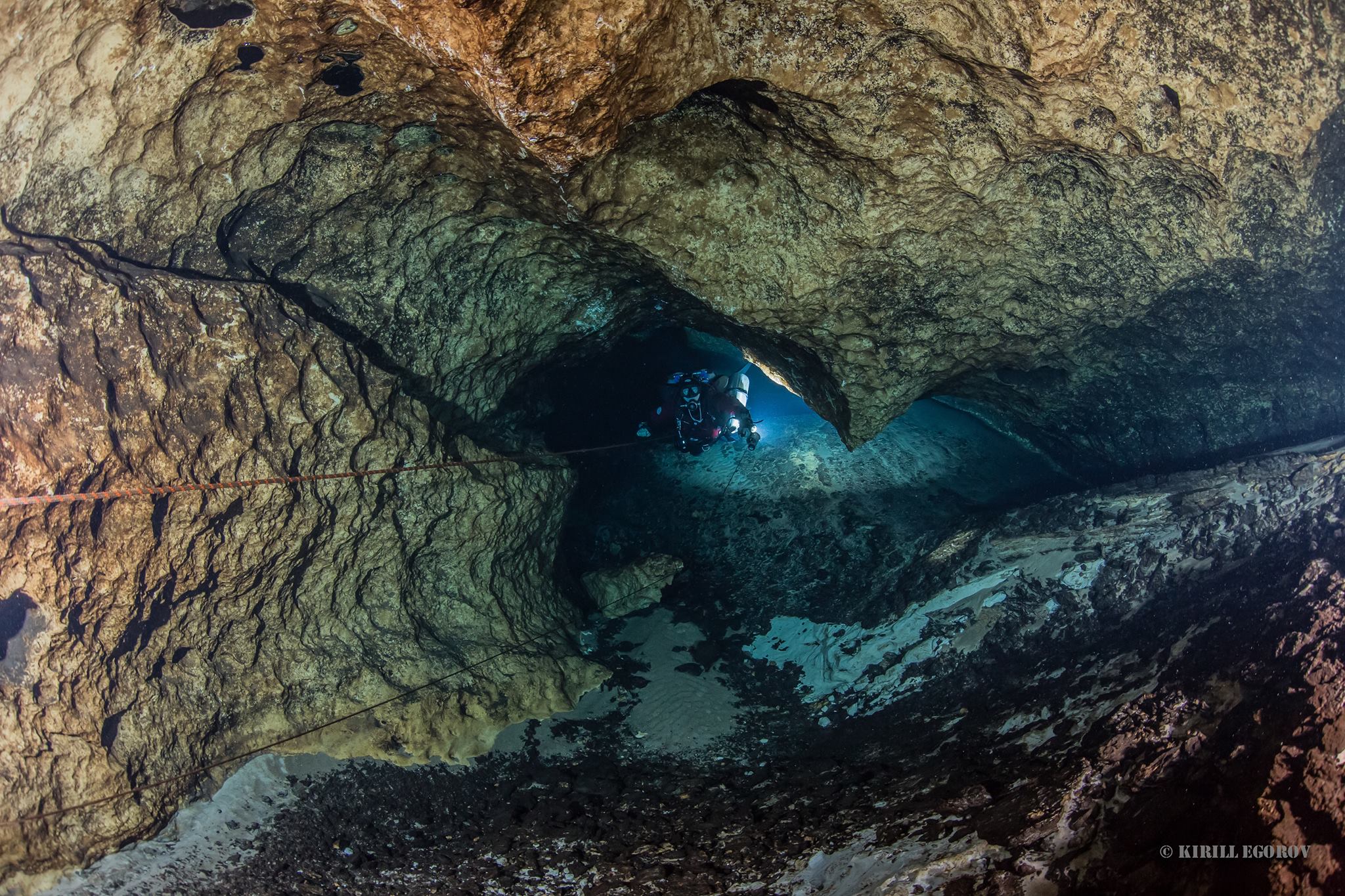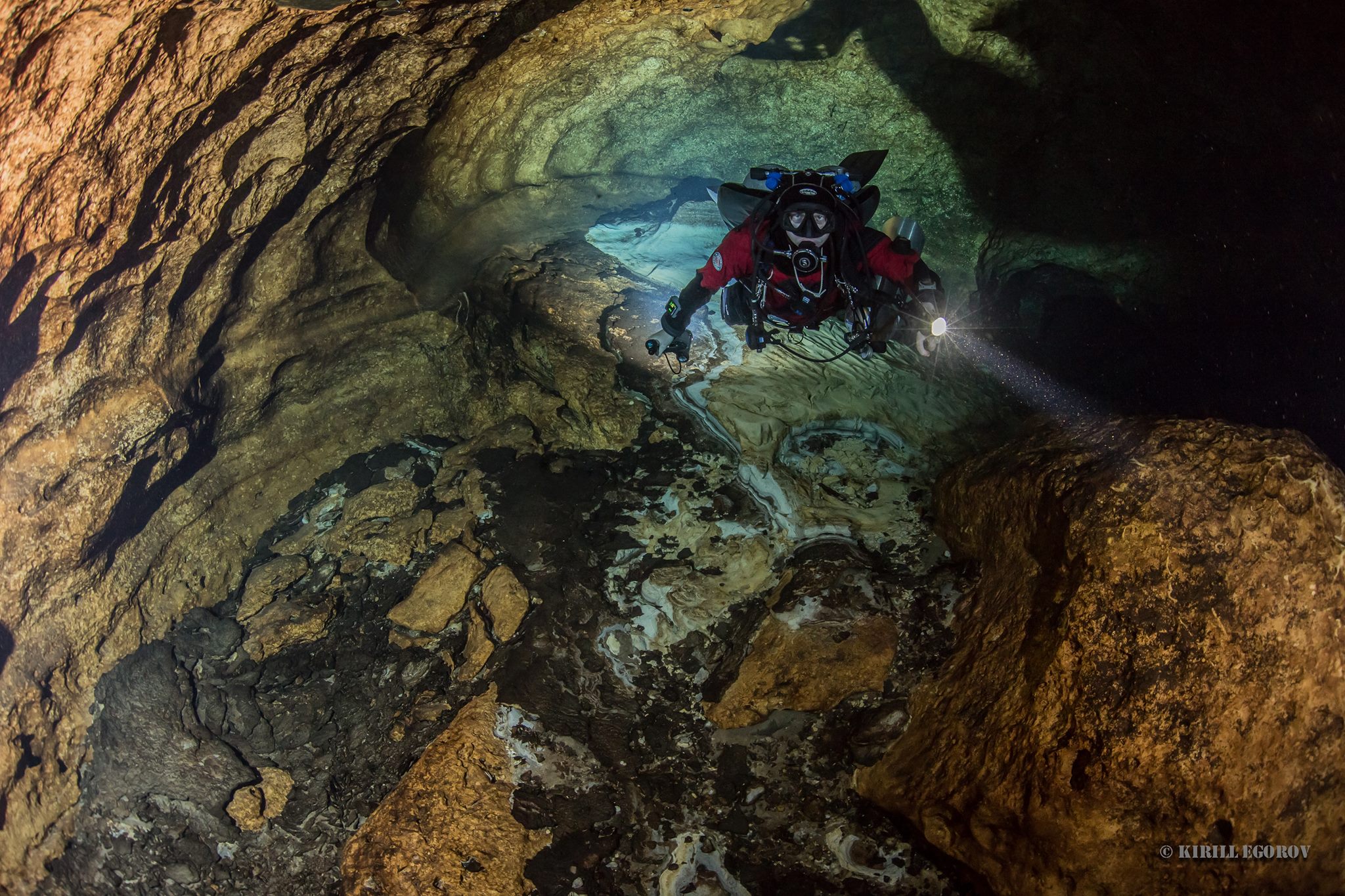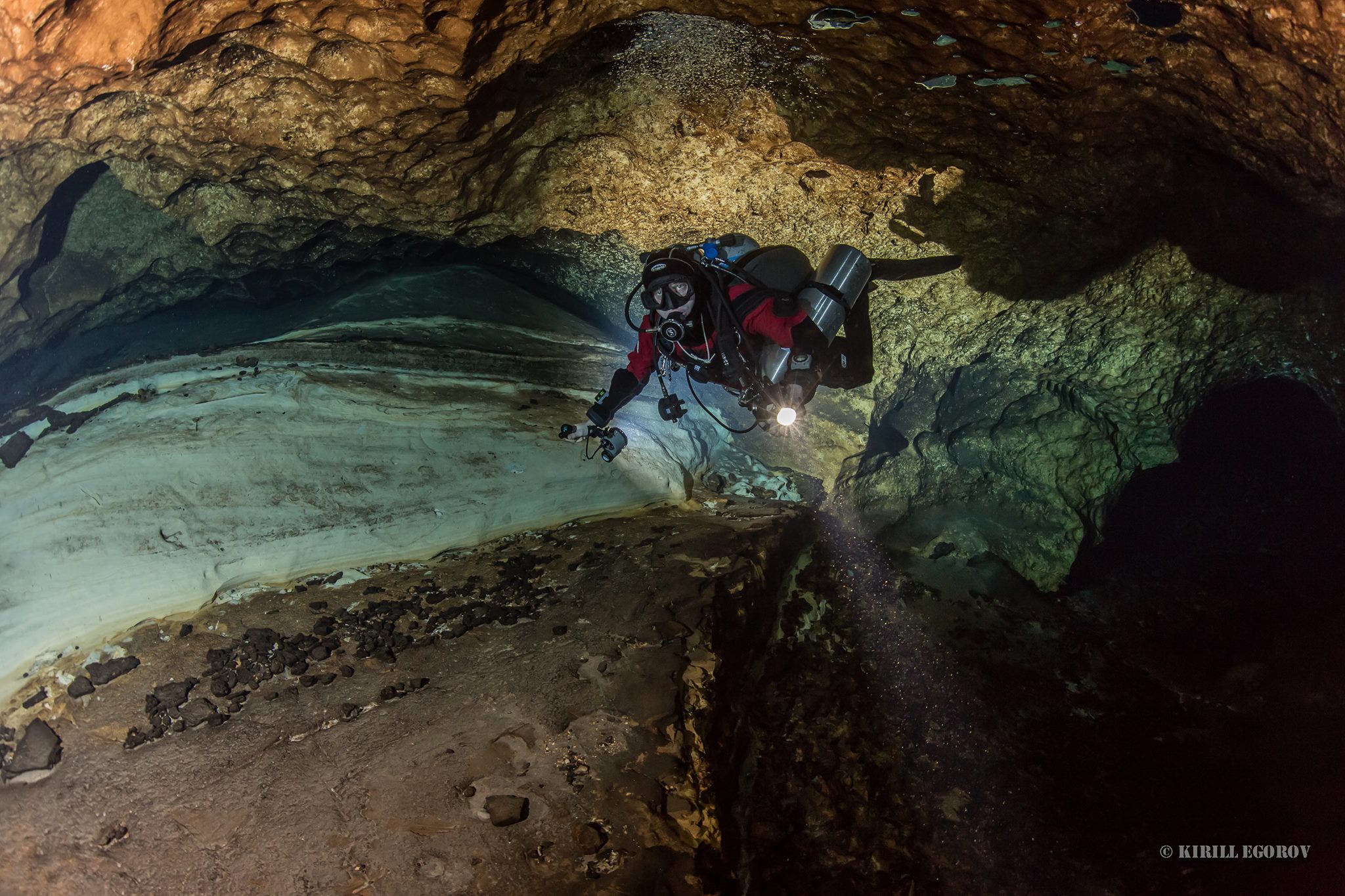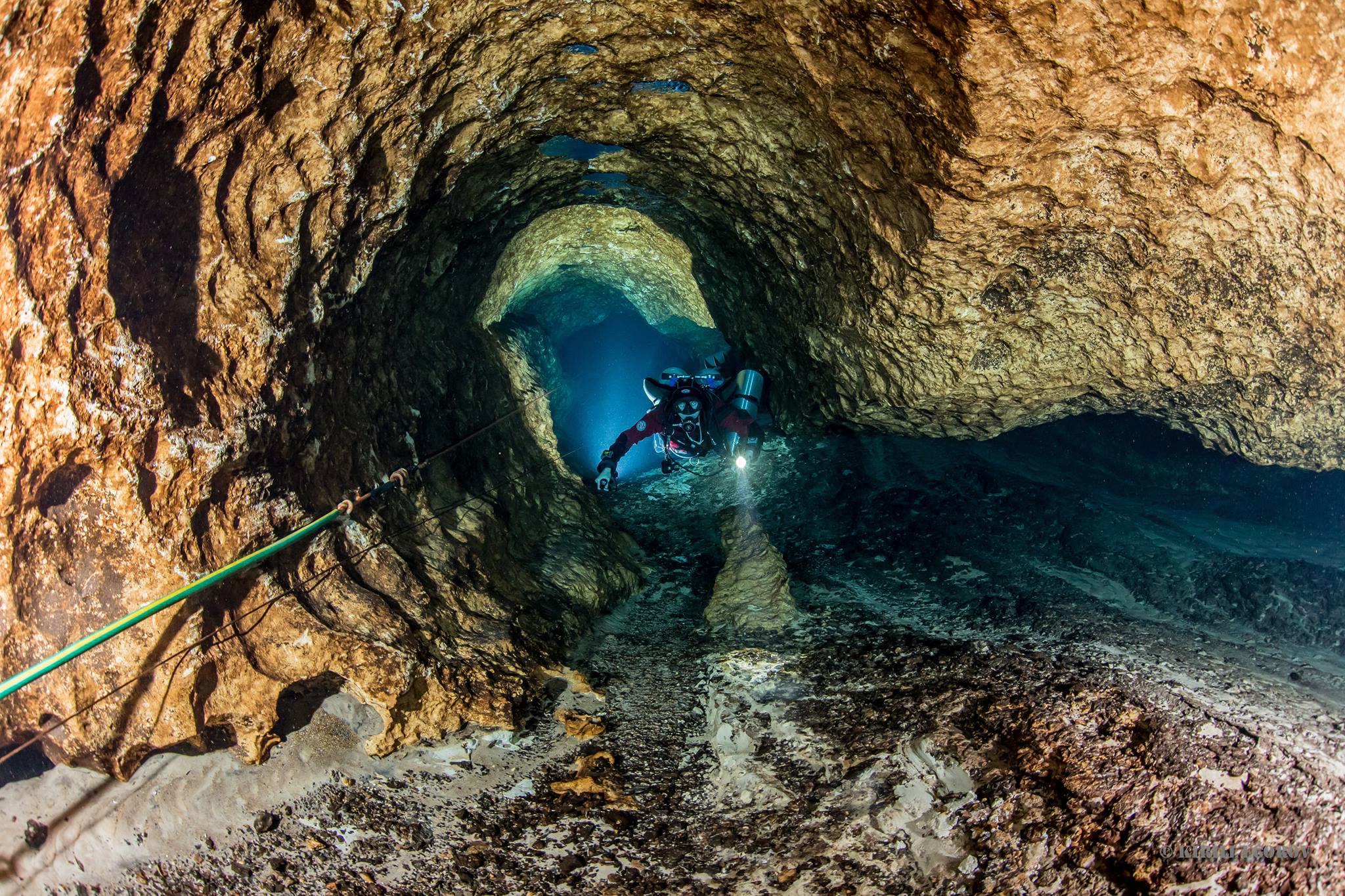Location
Someone once compared Cow Spring to a piece of Japanese origami sculpture. At first glance, there does not appear to be that much to it; yet, as one probes deeper, it keeps unfolding to reveal more and more.
Many consider Cow Spring to be among the most beautiful of all north-central Florida cave diving sites. It is a beauty, however, that is imperiled by the very people who come to appreciate it.
Cow has recently recieved a much needed make-over thanks to volunteers and donations. There is now a wooden walkway, stairs, platform, and changing room that has greatly improved logistics and comfort.
Getting There
Although no signs mark the way to Cow Spring, it is relatively easy to find -- provided you follow directions.
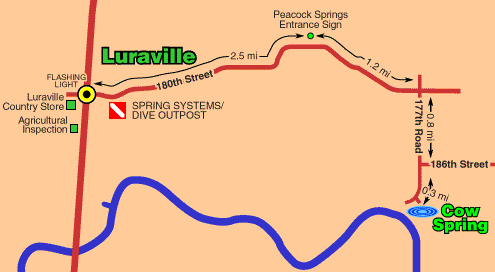
Site Access
Begin by taking State Route 51, either south from Live Oak or north from the US-27 intersection in Mayo.
At the flashing light in front of the Luraville Country Store, turn east on 180th Street -- the same road as you take to Peacock Springs State Recreation area.
Continue 1.2 miles past the main Peacock Springs entrance to the intersection of 180th Street and 177th Road. At this intersection, you will see the Pine Grove Church of God on your left; you will be turning right on to 177th Road.
Approximately 0.8 miles down 177th Road, you will reach the T-shaped intersection of 177th Road and 186th Street. Note your mileage, then continue straight through this interection.
Approximately 0.2 miles further, the road will begin a large, sweeping curve to the right. Keep going. Approximately 0.3 miles past the 177th Road/186th Street intersection, in the middle of the curve, you will see a smaller dirt road on your left. This is the entrance to Cow Spring.
A few hundred yards/meters into the woods, the Cow Spring entrance road ends and you will find parking under the trees near the north side of the sink hole. The easiest and safest way to enter the water is to take the trail around the sink's left side (as you face it from the parking area). This leads to a series of natural stone ledges and steps on the east side of the sink hole.
In years past, access to Cow Spring was available intermittently, as various land owners would, at times, gate or post the property. With the purchase of the site by the National Speleological Society Cave Diving Section (NSS-CDS), however, access was assured for years to come.
The Upstream entrance to Cow Springs has a major restriction requiring moderate body and equipment manipulation to pass through a roughly vertical to horizontal transition at about 40 feet of depth. Current flow is typically quite high requiring the use of a pull rope permanently installed in the front section of the cave. Visibility is normally very good with depths to the 90-110 foot range. The upstream section is quite delicate and is considered an advanced cave dive. Divers MUST ensure their buoyancy control is excellent prior to entering this system as it contains spectacular clay banks and delicate goethite formations throughout that are easily damaged as well as challenging high flow and additional restrictions beyond the entrance.
Site Layout
Strictly speaking, Cow Spring is not a spring at all, but a sinkhole with both spring and siphon sides. Water flows toward Cow Spring from the northeast, in the same general direction as it does to the neighboring Peacock/Orange Grove and Telford systems. From a depth of 70 feet/21 meters, this water wells up through the boulders at the base of the sinkhole's debris cone, then flows into either of two siphon tunnels on its west side.
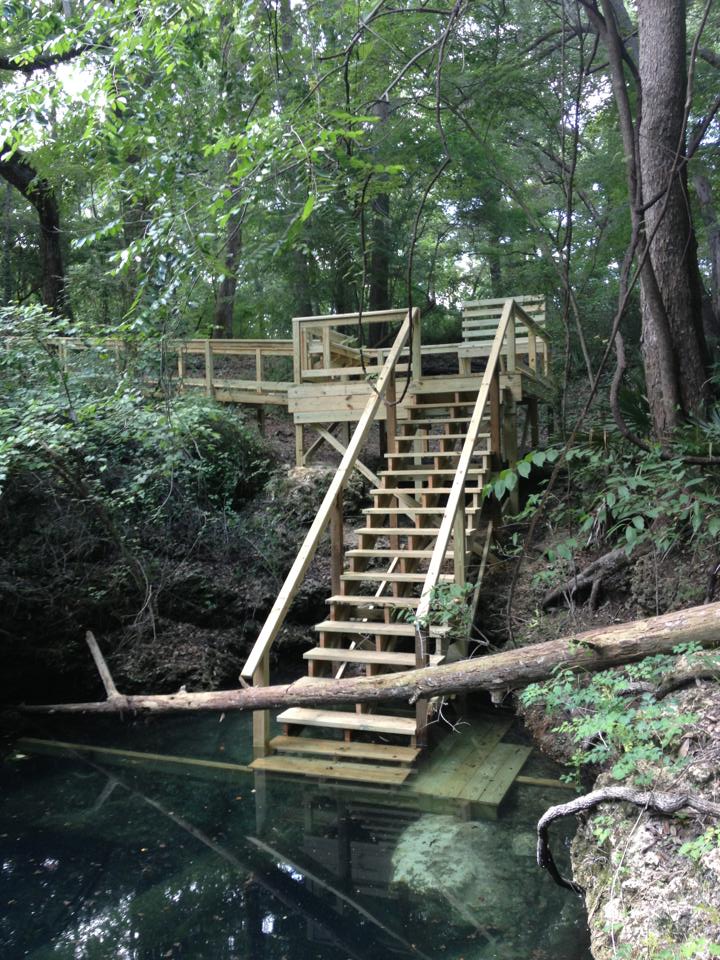
Cow Springs Basin
From here, the water travels another 500-600 feet/150-180 meters, to emerge at two resurgences along the north bank of the Suwannee River which, together, are known as Running Spring. As yet, no one has successfully made the connection between Cow and Running Springs; both siphon tunnels become effectively impassable approximately 400 feet/120 meters downstream.
From the surface, under normal conditions, all one sees is a pool of water roughly 20 feet/6 meters wide and, depending on water level, 40-60 feet/12-18 meters long. Water clarity permitting, you will see that the sides of the sinkhole quickly narrow to an opening roughly half this size, just below the surface. From here, however, the walls of the sinkhole bell outward dramatically, expanding to several times the size of the surface pool. At the base of the sinkhole's debris cone, divers will find three main cavern areas and several smaller ones.
Immediately below the point at which most divers enter the water, a small cavern extends approximately 50 feet/15 meters southeast. At its furthest point, a small opening allows sunlight to enter the back of the cavern.
Opposite the entry point, at the sink's northwest corner, is a vertical fracture over 40 feet/12 meters high. This cavern extends back over 60 feet/18 meters. Despite its height, divers generally find they can reach out and touch both side walls for almost its entire length.
On the west side of the sinkhole, divers will find the largest of the site's three main caverns. This cavern reaches a depth of approximately 40 feet/12 meters at normal water levels; this is the deepest point one finds on the siphon side of Cow "Spring."

As the map shows, this largest of the three caverns actually forms a loop. It is also from this cavern that one finds the two cave passageways leading toward Running Spring.
The north siphon tunnel is somewhat easier to find; it contains what most divers consider to be the "main" line. The line runs slightly over 300 feet/90 meters, through a fascinating combination of low/wide bedding planes and an inverted-"T" fracture. There are several interesting phreatic formations -- especially near the beginning of the line. Use of sidemounts may enable divers to reach the end of this line; however, in doing so, they will only get a few body lengths farther than most of us can reach using back-mounted cylinders.
The south siphon tunnel is not as readily visible as the north tunnel; however, you should be able to find it if you look for it. It will be on your left as you enter the west cavern. This tunnel more closely resembles a smaller version of the phreatic tunnels one finds in the neighboring Peacock system. Like the north siphon tunnel, one reaches a point, roughly 400 feet/120 meters back, where the passageway becomes too small to continue on back-mounted cylinders. Using sidemounts, however, will not get you much further. Divers willing to explore a little bit will find a third tunnel, paralleling the south siphon passage. It, too, does not go very far.
Cow "Spring" has the distinction of being the only popular cave diving site in the Suwannee River Valley in which divers regularly explore an active siphon. In fact, many instructors take students here. However, one must bear in mind:
- The normal siphon flow is very mild.
- This siphon is the result of being on the opposite side of a spring. Therefore, unlike a siphon caused by the reversal of a spring, the water is normally very clear.
- Even divers using single cylinders will likely run out of cave before exhausting more than a sixth of their starting gas supply.
Diving Cow
Cow Springs was purchased by the NSS-CDS and is open only to NSS-CDS members. The property is gated and requires a code for access. Please visit the Cow Springs Cave webpage for more information. You can also get up to date information on Facebook in the group "Cow Springs Cave Diver". NSS-CDS membership can purchased at https://nsscds.org/join/.
Some History
For many years, the upstream side of Cow Spring was accessible only to divers using sidemounted bottles -- and only if such divers knew where to find the very obscure spring entrance. That is, until Lamar Hires was walking to the water with a group of cave diving students. As he passed two local open-water divers, on the trail leading down to the water's edge, he overheard them discuss having reached a depth of 70 feet/21 meters.
Knowing that this was normally impossible, using back-mounted cylinders, Lamar offered these two a free cave diving course (something they badly needed) if they would show him where they had been. As it turned out, these two untrained divers had managed to discover a second entrance to upstream Cow -- one that had eluded experienced cave divers for years.
The discovery of a back-mount entrance to Cow Spring brought both elation and fear. On the one hand, it meant that nearly any cave diver could now see the very beautiful upstream Cow passageway -- a passageway largely undamaged by the onslaught of divers who visit the area's other popular sites. On the other hand, this very accessibility now put upstream Cow's fragile formations in peril.
There have been several documented incidents of damage which are reasons for concern. Some years past, a careless diver left a hand and fin print in the once-beautiful stratified clay bank located just downstream of Not My Fault. This effectively destroyed what was once among this cave's most unique features. What is particularly aggravating is that this clay bank is located several body lengths from the main line. It is easily viewed from a distance. There is absolutely no reason for any diver to even come close to it. More recently, a diver carved his initials into a mud bank closer to the entrance. The offender was tracked down and the damage was ameliorated to some extent through no small effort.
For these reasons, many cave divers who know how to do so are reluctant to divulge exactly how one gets into upstream Cow. Neither the old sidemount or new back-mount entrance are something you are likely to find on your own. Therefore, the only way most cave divers are likely to get into upstream Cow is to be shown how to do so by another diver who trusts their ability to not cause damage.
Diving Upstream Cow
Even if one knows where to go, getting into Upstream Cow is not easy. The entrance is a very snug-fitting restriction, and divers must pass through a second restriction not long after entering. Flow is generally brisk -- in fact, between Rockstream Drop and Not My Fault (an area with few environmentally sound hand holds), there is a polypropelene "pull along" line to facilitate getting through a section of cave where is it often impossible to make headway by kicking alone. (This is what Woody Jasper calls "the poor man's scooter.")
Depths run in the 60-foot/18-meter range for the first 300 feet/90 meters of penetration. Here they drop to the 70-foot/21-meter range until one reaches Not My Fault, roughly 700 feet/210 meters from the entrance. Upstream of Not My Fault, one encounters depths in excess of 100 feet/30 meters.
Other Considerations
The majority of the Cow Spring system was surveyed during the mid-1980s by Wes Skiles, Woody Jasper, Lamar Hires and Tom Morris. A map Wes Skiles made at that time is available from the NSS-CDS.
Given its proximity to the Suwannee River, Cow Spring is subject to seasonal flooding. It will, in fact, generally "go dark" before the neighboring Peacock system will. What is interesting is that, when Cow does flood, it is not because river water enters from above ground, as is typical of most other systems. Rather, the dark river water enters through what are normally resurgences at Running Spring, and backs up through the siphon tunnels.
Because of erosion concerns, in 2013 fundraising enabled the construction of a boardwalk and entry stairs. In 2014 a tank stand was also added. A picnic table and port-a-potty are the only other facilities. Occasionally local residents are able to by pass the fencing on the property and trespass with ATV's and similar motorized vehicles; locking your valuables is prudent.
The path is frequently overrun by poison ivy in the spring and summer months. Those who are allergic take heed.
The closest fill station to Cow Spring is Dive Outpost on 180th Street, near the Luraville intersection. The closest hospital is in Live Oak. Emergency Medical Services and police protection is provided by Suwannee County.
NSS-CDS Conservation and Management Plan
The following is borrowed from their website and reflects the current standards for diving at this special location:
The Upstream entrance to Cow Springs has a major restriction requiring moderate body and equipment manipulation to pass through a roughly vertical to horizontal transition at about 40 feet of depth. Current flow is typically quite high requiring the use of a pull rope permanently installed in the front section of the cave. Visibility is normally very good with depths to the 90-110 foot range. The upstream section is quite delicate and is considered an advanced cave dive. Divers MUST ensure their buoyancy control is excellent prior to entering this system as it contains spectacular clay banks and delicate goethite formations throughout that are easily damaged as well as challenging high flow and additional restrictions beyond the entrance. The following site specific rules apply to the upstream section of Cow Springs:
1. Diving is per the "Diver" section of this document with the exception that it is open to divers certified at Cave Diver or equivalent certification and there is no requirement to show proof of 100 cave dives.
2. DPV use is forbidden.
3. Training is prohibited EXCEPT sidemount training ONLY is allowed. Sidemount training may only be conducted by NSS-CDS Instructors for students meeting all of the requirements of the “Diver” section of this document. All divers entering the system must already be proficient in buoyancy control and be able to exercise proper technique to avoid damaging the cave while sidemount diving. Instructors and sidemount students are both charged with evaluating skill levels and the appropriateness of using this fragile site for training.
The Downstream section of Cow Springs is shallow, in the 30 foot range, and fairly wide open with roughly 450 feet of penetration possible with no significant difficult areas. The following site specific rules apply to the downstream section of Cow Springs:
1. Diving is per the “Diver” section of this document with the exceptions that it is open to all levels of Cavern and Cave Diving and there is no requirement to show proof of 100 cave dives after full cave.
2. DPV use is forbidden.
3. All levels of Cavern and Cave Diving training may be conducted only by NSS-CDS Instructors for students diving per the “Diver” section of this document, with the exception that the students Cavern/Cave certification level must be appropriate to the level of training being conducted.
Note: Over the years there have been various changes to the plan outlined above. It is recommended that divers heading to Cow check on the latest regulations for diving this spring--the Management Plan can be found on the NSS-CDS website under dive sites management plan.

